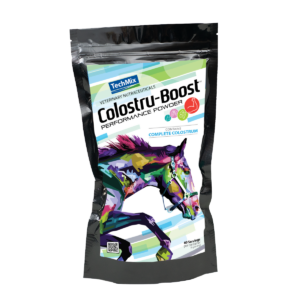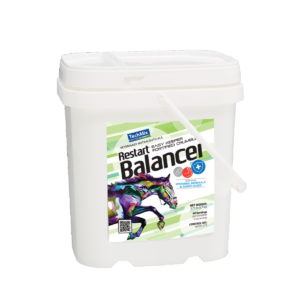June 20, 2025
Clinical Veterinary Perspective-Metabolic
Generally speaking, “metabolism” refers to the body’s complex process of converting food into energy for usage and storage. When talking to clients while evaluating their horses, metabolic topics of particular concern to them are primarily grouped within a category we refer to as Equine Metabolic Syndrome (EMS). Many owners start by asking if their horse has Cushing’s disease, some wonder if their horse is hypothyroid, some ask about blood sugar, some want their horse tested for PPID. The word “syndrome” in medicine gets used when a condition can present with several different symptoms or maybe has multiple closely related causes. Sometimes the individual may present with multiple symptoms of varying severity, maybe just one, or may not be showing many signs at all. So my clients are generally on the right track when they ask about any one of those conditions, because if there turns out to be a low thyroid level, a high cortisol level, a high blood glucose level, a high insulin level, or a high ACTH level, their horse will likely get diagnosed with some flavor of Equine Metabolic Syndrome. From there, a management and treatment protocol would be tailored for the particular variation the horse exhibits.
The endocrine system consists of anatomical glands which produce hormones sent into circulation (think: pancreas for insulin, adrenal glands for cortisol, etc.). They are self-regulating through feedback mechanisms signaling production of the right amount of a particular hormone at any given time and circumstance, but also take direction from the nervous system for input signals (think: I just ate a candy bar, the nerves in my stomach have detected input, and now my pancreas is surging out some insulin, or I just encountered a bear in my campsite, my nervous system triggered my fight or flight survival response, and now my adrenal glands have squeezed out some cortisol). Equine Metabolic Syndrome can consist of insulin dysregulation where the appropriate feedback mechanisms are broken, or at best confused as to whether to use or store glucose. There can be primary thyroid gland problems causing them to secrete too little hormone, primary adrenal problems causing them to secrete too much cortisol, or quite commonly, the underlying problem is really at the pituitary gland. The pituitary gland can be thought of as the mothership and sits at a rather inaccessible area right under the brain. It is the junction of the nervous and endocrine systems, taking nerve input in, and sending up-regulating and down-regulating feedback signals to each of these other glands. Horses can develop tumors on the pituitary gland commonly on an area called the pars intermedia, and thus goes by the term Pituitary Pars Intermedia Dysfunction, or PPID.
Clinically, the most common reason the horse owner or I are interested in finding out if EMS is in the picture is to know if it is the underlying cause of any of the symptoms we are seeing. These symptoms can include a shaggy hair coat that does not shed out in a typical or timely manner in the spring, a cresty neck or fatty deposits around the hind quarters or base of tail, an abnormal Body Condition Score, or most concerning, sore feet or laminitis. Veterinarians can run individual blood parameters or submit panels that involve multiple steps like a baseline blood sample followed by an injection that will send a signal to the endocrine system to make a change. Lastly, we can take a second sample later in time to compare the change. Sometimes we can get confirmation on a single blood parameter at a single moment in time, but in most cases and to avoid missing the whole picture, we need to submit a panel that will check a number of things—minimally ACTH and insulin, but often thyroid, cortisol, blood sugar, and sometimes more. When we get results back, EMS and the specific variation of EMS, can generally be ruled in or ruled out as the underlying cause of the symptoms the horse is experiencing.

Nutrition and management for these cases are as important, if not more, than medications we have available for treatment. In each case, utilizing an effective medication for the type of EMS diagnosed, such as pergolide, metformin, thyroxine, etc., would be done in conjunction with nutritional modifications. Such management interventions are aimed at minimizing sugar and starch intake leading to high blood sugar and insulin, as well as reducing the circulating level of the stress hormone, cortisol. These management interventions may include:
- Dry lotting
- Eliminating grain from diets
- Limiting pasture time
- Hay testing for nonstructural carbohydrate levels
- Soaking the hay in water or steaming before feeding
- Using hay nets to promote slow but steady intake
- Exercise
- Stress reduction
… and more. Adding in the appropriate medication for the condition does not eliminate the need for these management practices.
Some nutraceutical options can be incorporated into the management strategy of these horses but opinions will vary depending on with whom you are talking. When supplementing with bovine colostrum, studies show a reduction of blood sugar levels in humans with diabetes, so for that reason, I consider Colostru-Boost® products an option for EMS horses. Flax seed has been promoted for some metabolic syndrome horses, especially when laminitis is present. Restart® Builder contains flax and could be incorporated into the plan for an EMS horse that has a BCS below 5. Additionally, anti-inflammatory omega fatty acids and calming thiamine are present within Restart Builder. For those EMS horses that are above a 5 BCS, Restart® Balancer could be considered for the vitamins, minerals, and biotin to support hoof health and overall wellness, and for the calming potential of thiamine and lysine.
In my experience, EMS cases have not been one-size-fits-all by any means. The diagnosis of EMS is truly the starting point and the journey that follows varies tremendously from horse to horse as to which combinations of medication, management, and supplements work best for that individual. Before arriving at the best protocol for the horse, it is expected that we will make addition or subtraction adjustments based on response to treatment, often repeating bloodwork to compare with the level of physical symptom improvement over periods of time.


